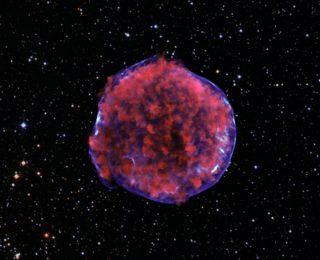
by Kerrin Hensley | Dec 12, 2017 | Daily Paper Summaries
Supernova remnant magnetic fields may play a key role in accelerating electrons to relativistic velocities. West et al. investigate the magnetic field conditions inside young supernova remnants and discover that they may not be as well-behaved as they appear.

by Jesse Feddersen | May 2, 2016 | Daily Paper Summaries
Gravity turns gas into stars. Today’s astrobite introduces a new way to study gravity’s pull in a molecular cloud – the birthplace of new stars.

by Adele Plunkett | Dec 8, 2015 | Daily Paper Summaries
Today we review a study searching for a way to measure the ages of stars in a galaxy. The quantity of long period variable stars gives information about the life cycle of a galaxy, and the authors explain that with their new technique it is possible to take the “pulse” of a galaxy.

by Brett Deaton | Jan 28, 2015 | Daily Paper Summaries
In today’s paper, Rezzolla and Kumar present a solution to the x-ray afterglow problem for the short gamma ray burst model. They show that x-rays can glow steadily for hours after the initial gamma ray emission due to the interactions of a slow and a fast wind.

by Elizabeth Lovegrove | Sep 23, 2013 | Daily Paper Summaries
In this paper the authors present simulations of a model to explain rapidly-fading supernovae, a class of transients whose lightcurves decline quickly without substantial radioactive tails. They posits a standard core-collapse explosion of a standard Type Ib/Ic supernova progenitor, but one that produces very little radioactivity and instead exhibits a light curve governed by oxygen recombination.

by Caroline Morley | Oct 19, 2012 | Daily Paper Summaries
Astronomers don’t stop after discovering planets in systems near and far from our own solar system. The next big step is to characterize the planets. We want to understand what they’re made of, what their atmospheres look like, whether they have clouds, how massive they are, how old they are, etc. As it turns out characterizing exoplanets is really, really challenging for both observers and modelers. The challenges encountered are well illustrated by the saga of WASP-12b.






